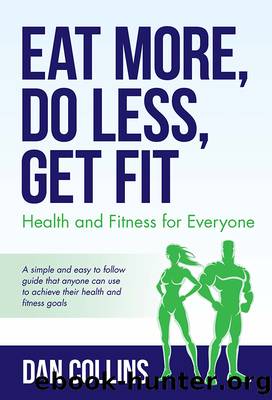Eat More, Do Less, Get Fit by Dan Collins

Author:Dan Collins
Language: eng
Format: epub
Publisher: Dan Collins
Published: 2020-07-07T00:00:00+00:00
Target fat-burning heart rate zone:
75% to 85% of your max heart rate
Sample calculation:
Age: 58
Resting heart rate: 72
[(220â58)â72] * (1 + 72) = (162-72) + 73 = 163
Minimum fat-burning heart rate:
75% of max = 163 * 0.75 = 122
Maximum fat-burning heart rate:
85% of max = 163 * 85% = 139
Target fat-burning heart rate zone = 122â139
The most effective fat-burning heart rate range for the example above is 122â139, but for simplicity's sake you can round to 125â140. This is the range that the person from this example would want to stay within when performing their cardio workouts. If you do not have a heart rate monitor or are not using equipment that does, a good way to estimate this range is that when you are training, you should be able to carry on a conversation with little to moderate effort in conjunction with the increased labored breathing caused by the demands of your workout.
Now for more of the Do Less part of Eat More, Do Less, Get Fit. When you are performing your progressive weight training routines, your heart rate will most likely enter this same target heart rate range. Yes. Progressive weight training utilizes short bursts of energy at near maximum effort, but you also rest in between sets. Even though this training elevates your heart rate, it usually does not raise it above your target heart rate zone, and if it does, it is only momentarily, and your heart rate quickly returns to the appropriate range. Sort of like a mini-HIIT (high intensity interval training) cycle. Furthermore, since progressive weight training is based on sets and reps, you can easily manage your workout to maintain your target heart rate zone.
Another aspect of training that you will hear about quite often is âcore trainingâ. To me, this means âbalance trainingâ, as opposed to ab training. Many trainers will have you doing multiple concurrent movements to âengageâ your core. I am skeptical of this at best in that it seems to only complicate the base movement and detract from the results. I would encourage you to use balance movements such as yoga, but if yoga is not your thing, then there are lots of alternative activities and exercises that you can do to build your balance.
Balance is not an innate thing that you lose as you get older. What actually happens is the small muscles that your body uses to maintain its balance start to atrophy due to lack of use. When you were younger you probably participated in sports in school or just played outside in the backyard. Or maybe you just danced a lot more when you were younger. As we get older and work takes over a large percentage of our time, we find ourselves sitting far more than we are designed to do. This is how these âbalanceâ muscles atrophy. You just need to start using them again, and to be honest, it does not require a lot of effort. Just a few minutes a couple times
Download
This site does not store any files on its server. We only index and link to content provided by other sites. Please contact the content providers to delete copyright contents if any and email us, we'll remove relevant links or contents immediately.
Unwinding Anxiety by Judson Brewer(72675)
The Art of Coaching by Elena Aguilar(52845)
The Fast Metabolism Diet Cookbook by Haylie Pomroy(21027)
Rewire Your Anxious Brain by Catherine M. Pittman(18496)
Healthy Aging For Dummies by Brent Agin & Sharon Perkins RN(16970)
Talking to Strangers by Malcolm Gladwell(13144)
The Art of Thinking Clearly by Rolf Dobelli(10150)
Crazy Rich Asians by Kevin Kwan(9136)
Mindhunter: Inside the FBI's Elite Serial Crime Unit by John E. Douglas & Mark Olshaker(9115)
The Compound Effect by Darren Hardy(8742)
Tools of Titans by Timothy Ferriss(8164)
Periodization Training for Sports by Tudor Bompa(8105)
Becoming Supernatural by Dr. Joe Dispenza(8047)
Wonder by R. J. Palacio(7884)
Crystal Healing for Women by Mariah K. Lyons(7829)
Bodyweight Strength Training by Jay Cardiello(7810)
Therapeutic Modalities for Musculoskeletal Injuries, 4E by Craig R. Denegar & Ethan Saliba & Susan Saliba(7666)
Change Your Questions, Change Your Life by Marilee Adams(7575)
Should I Stay or Should I Go? by Ramani Durvasula(7525)
